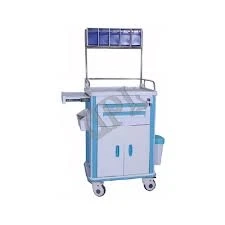Efficiency and organization are crucial in the hectic and complicated environment of healthcare institutions, particularly in critical care areas like operating rooms. The anaesthesia trolley, a specialized piece of equipment made to optimize patient care and anesthesiologists\' workflow, is one of the most important elements in these situations. This article examines the features and choices available for anaesthetic trolleys and emphasizes how they improve medical effectiveness.
1. Understanding the Role of Anaesthesia Trolleys
Anaesthesia trolleys play a critical role in the operating room. They are designed to hold and organize the myriad of tools, medications, and equipment necessary for administering anesthesia. The primary purpose of these trolleys is to provide easy access and efficient organization, ensuring that anesthesiologists have everything they need within arm\'s reach during surgical procedures.
2. Key Features to Consider
When exploring anaesthesia trolley options, several key features should be considered:
Mobility: Trolleys should be easy to move around, with smooth-rolling, lockable wheels for stability during use.
Drawer Configuration: The number and size of drawers should be sufficient to accommodate various tools and supplies, with customizable dividers for organization.
Build Quality and Durability: Given the demanding environment, trolleys should be made from durable materials that can withstand regular use and easy to clean for infection control.
Security: Secure locking systems are crucial for controlling access to medications and sensitive equipment.
Work Surface: Adequate and expandable work surfaces are necessary for the preparation of medications and tools.
3. Types of Anaesthesia Trolleys
Anaesthesia trolleys come in various types, each with unique features tailored to different operational needs:
Standard Trolleys: These are the most common types, equipped with basic features like drawers, shelves, and a worktop.
Modular Trolleys: These trolleys offer more customization with interchangeable components and accessories, allowing for greater flexibility.
Electronic Trolleys: Incorporating technology, these trolleys can feature electronic locking systems, built-in computers or tablets, and automated inventory tracking systems.
4. Customization and Accessories
Customization is a key aspect of choosing an anaesthesia trolley. Facilities can choose accessories like IV poles, oxygen tank holders, waste bins, and additional storage options. This customization ensures that the trolley meets the specific needs of the healthcare staff and the procedures performed.
5. The Impact on Patient Care
A well-organized anaesthesia trolley not only enhances efficiency but also improves patient care. Quick and easy access to necessary equipment and medications means that anesthesiologists can focus more on the patient, responding promptly to any situation that may arise during surgery.
6. Considerations for Different Healthcare Settings
The choice of an anaesthesia trolley can vary based on the healthcare setting. Large hospitals may require more advanced trolleys with electronic systems, while smaller clinics might benefit from more basic, modular options. Assessing the specific needs of the healthcare facility is crucial in selecting the right trolley.
7. Maintenance and Care
Maintaining anaesthesia trolleys is essential for their longevity and effectiveness. Regular cleaning and inspection of wheels, drawers, and locking mechanisms are necessary to ensure they function properly and meet hygiene standards.
8. Technological Integration
In an era of digital healthcare, integrating technology with anaesthesia trolleys is becoming increasingly important. Options like barcode scanners for inventory management and electronic documentation systems can greatly enhance efficiency and accuracy in the operating room.
9. Training and Usage
Proper training on the use and features of the anaesthesia trolley is essential for staff. This ensures that all potential benefits of the trolley are fully utilized and that it is used in a safe and efficient manner.
10. Future Trends
Looking ahead, trends in anaesthesia trolleys include the integration of more advanced technologies, such as AI and machine learning, for predictive analytics in inventory management and enhanced patient care.
Anaesthesia carts are much more than just storage spaces; they are essential instruments that greatly enhance the efficacy and efficiency of surgical treatments. In addition to improving patient care results, healthcare facilities may significantly increase their operational efficiency by carefully weighing their alternatives, tailoring their design to meet unique requirements, and embracing technological improvements. The powers and functions of these vital pieces of equipment will advance along with the medical technology industry, supporting the vital job of healthcare professionals.
Also Read: How to use an anesthesia trolley safely and effectively



